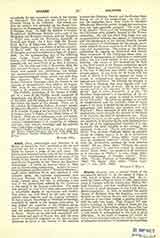

Allard, PAUL, archaeologist and historian, b. at Rouen September 15, 1841, admitted to the bar and practiced law for a short time in his native city, where he became a judge of the civil court. His literary and historical tastes induced him to abandon his profession and devote himself to the study of the history of the Church in the first four centuries. He contributed frequently to the “Revue des Questions Historiques”, of which he became editor in 1904, and to various other publications. In 1874 he translated Northcote and Brownlow’s “Roma Sotterranea”, made many additions to it, and enriched it with valuable notes. An intimate acquaintance with Giovanni Battista De Rossi and his own studies along various lines, led him to undertake a history of the persecutions suffered by the Christians at the hands of the Roman authorities. The work was planned on very broad lines and executed with a remarkable degree of minuteness and finality. The author was well fitted for his task; his sympathies were Catholic and his reading extensive; he had a minute knowledge of Christian archaeology, especially in regard to the Roman Catacombs; he had studied the condition of the Christian slaves, and had a thorough acquaintance with epigraphy and the administrative and constitutional history of Rome. Above all he was well acquainted with the history and spirit of Roman law, and was competent to pronounce judgment on the delicate legal questions involved in the history of the relations between the Christian Church and the Roman State during the era of the persecutions. On this subject his researches have done much to elucidate difficult and debatable points, though his conclusions have not been generally accepted. The main idea of M. Allard’s “History of the Persecutions” is that the Christians were unjustly treated by the Roman authorities. He will not admit that there was any incompatibility between the spread of Christianity and the permanence of the Roman Empire, though the acceptance of Christianity by the people necessarily implied the final eradication of the old Roman cults and superstitions. The action of the Roman authorities he regards as ill-advised and brutal. Their treatment of the Christians arose from no reasons of statesmanship or adherence to traditional policy, but was based entirely on low and unworthy motives. The causes of the persecutions he finds in the blind hatred of the Roman authorities against this “third race”, in fanaticism, popular fury, or, as in the case of Maximus and Decius, very largely in private spleen. If any fault can be found with the work of Allard, it is that he appears too ready to accept as contemporary historical sources mere legends and traditions. He followed the example of Le Blant in thinking that most legends and Acta contained some kernel of truth. He is not sufficiently radical in his criticism of the “Acta Martyrum” and of other documents, e.g. the “De Mortibus Persecutorum”, of Lactantius, all the assertions of which he seems to accept as testimony of the first order. He leans too strongly to the side of conservatism, and the scientific value of many pages of his work is spoiled by his reluctance to deal unsparingly with dubious and spurious Acta and Passiones. Many instances of this kind might be pointed out, as for example the account of the death of St. Irenaeus, the story of Symphorosa, etc. These remarks, however, do not apply to his work on Julian the Apostate, in which he shows more discrimination in the use of his hagiographical material; it is consequently the most valuable of his writings. His principal works are: “Rome souterraine” (Paris, 1874); “Les esclaves Chretiens depuis les premiers temps de l’Eglise jusqu’a, la fin de la domination romaine en occident” (Paris, 1876); “L’art paten sous les empereurs chretiens” (Paris, 1879); “Histoire des persecutions pendant les deux premiers siecles” (2d ed., Paris, 1892); “Histoire des persecutions pendant la premiere moitie du troisieme siecle” (Paris, 1881); “La persecution de Diocletien et le triomphe de l’Eglise” (2 vols., Paris, 1890); “Le Christianisme et l’empire romain” (Paris, 1896); “Etudes d’histoire et d’archeologie” (Paris, 1898); “St. Basile” (ibid., 1899); “Julien l’apostat”, 2 vols. (ibid., 1900).
PATRICK J. HEALY

